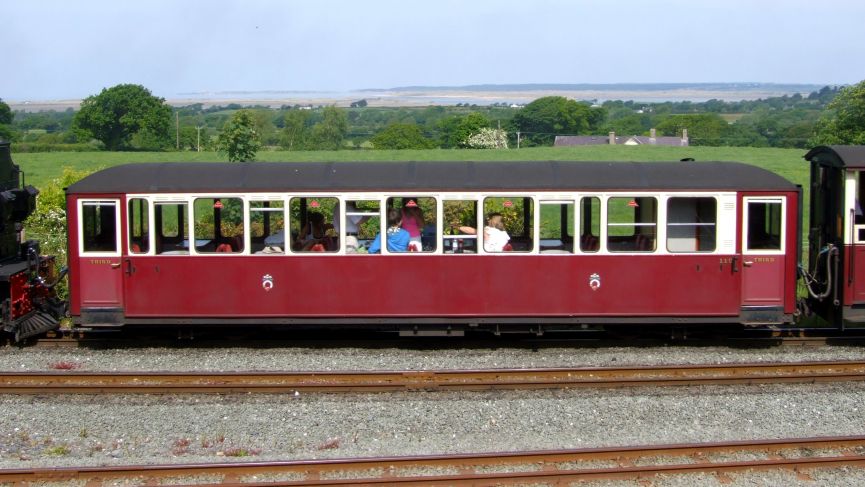The Golden Valley Light railway
A 2ft (610mm) Narrow Gauge Railway in Derbyshire
Carriage 119 - Timeline
Over the first half of 2016, work to bring the carriage into service has continued. After the arrival of the bogies from South Africa, they were checked over and one brake block that had been damaged in transit, was repaired. As the bogies will not have to carry the weight of a 40 tons waggon, two of the six springs, on either side of the bogies, were removed.
The plates that are fitted to the coach and sit on top of the bogies, where then designed, machined and fabricated, in house. In early June, the bogies the carriage was sitting on were swapped for the two South African ones, that it will run in service on.
A large proportion of the air brake equipment, has been designed and installed, the pull rods to the new bogies being the next job, now they are in place. The trainpipe and associated pipework, is also in situ.
The old dragboxes have been removed and refurbished. These can not be reinstalled on the carriage, until the height of the carriage above rail level has been assessed, so that the couplings, which will be attached, will end up at the correct height
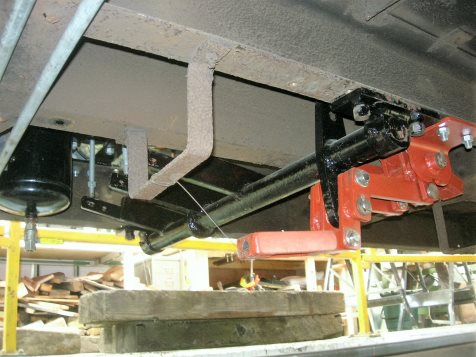
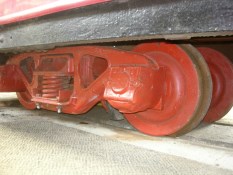
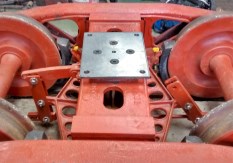
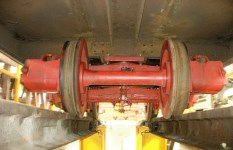
refurbishment nearly finished
The second ex Polish bogie, has reached the stage of final assembly. When the bogie was dismantled, it was found that one of the wheelsets was faulty, so it was replaced by one we had in stock. The replacement was slightly different, so time has been spent, slightly modifying the axle boxes, including white metaling.
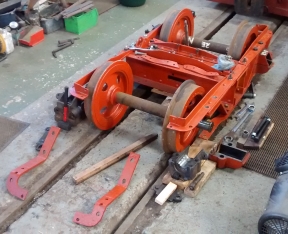
Refurbishment has continued, on the second ex polish bogie, though when completed and installed under, carriage 119, both polish bogies, will eventually be replaced by, refurbished bogies, that have been purchased from South Africa.
Work is continuing on making good the area formally occupied by the toilet cubical. As can be seen in the pictures, the side wall has now been completed. Work is now continuing on the ceiling, floor and electrics.
A separate project is the fitting of airbrakes and linkage to the carriage. The 3 brake cylinders were installed earlier in the Summer, since then the first part of the linkage they connect to, has been fabricated
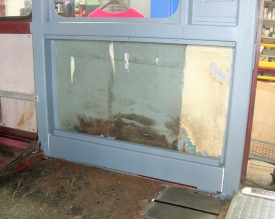
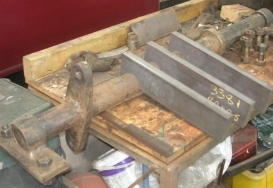
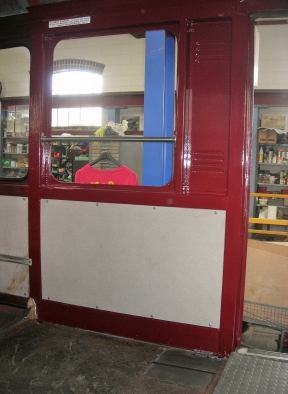
removal of toilet
Work on Carriage 119, has slowed over the Summer, whilst we run trains. But Wednesday evenings work parties have seen work continue, in the follwowing areas. The second ex Polish bogie has been dismantled and some cleaning and repainting completed. Stripping out and clearing of the toilet area has continued, the area is now ready for new floor, wall and ceiling coverings.
Steve has fabricated a frame, to hold the brake cylinders. This has been fitted to the carriage under one of the seats. To obtain the required braking force, 3 brake cylinders have been fitted in the frame, as can be seen, in the photo on right.
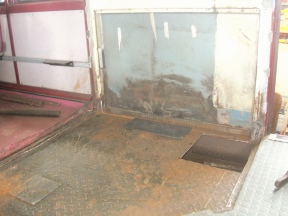
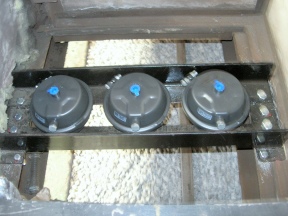
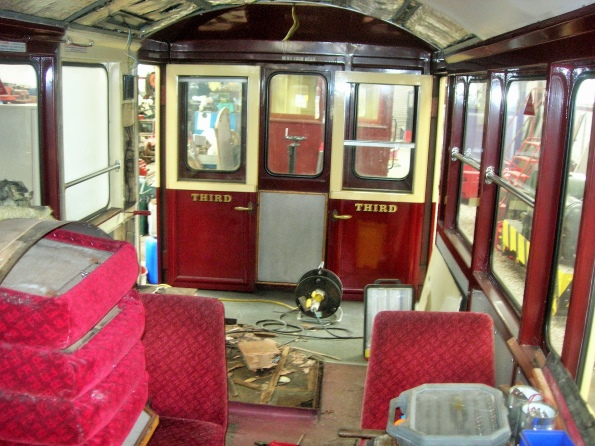
After 3 months of stripping down, refurbishment of parts and fabrication of replacements for wasted items, assembly has now started of the first bogie, to go under Carriage 119. The first photo below shows, the centre bolster. The yellow tubes are Polyurethane Die Springs, which we are using as replacements, for the life expired leaf springs. The springs were manufactured, to our specification, including damping and roll rate.
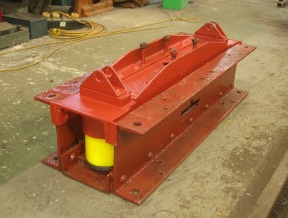
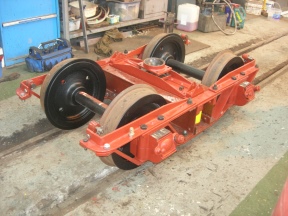
After the main bogie assembly, the cup that carries the weight of the carriage, was fitted on top of the bolster, a hole was drilled in the side to allow grease to be inserted, between the cup and cone for lubrication purposes. The grease nipple for this purpose, is at the end of a right angle pipe, due to restricted access.
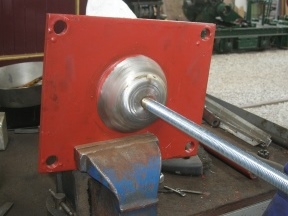
that sits in bogie cup
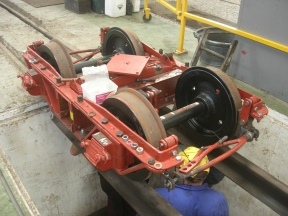
The cone, which sits in the bogie cup, is fitted to a plate that bolts to the underside of the carriage. Screwed into the bottom of the cone is a threaded bar, which passes through the bogie bolster and then has a plate attached, under the bogie, which keeps the bogie attached to the coach. With the bogie substantially complete, a decision was taken to install it under Carriage 119, so that various tests and measurements could be taken. Photos show the process of lifting the coach at one end and swapping the accommodation bogie, for the newly refurbished, 100year old ex PKP bogie.
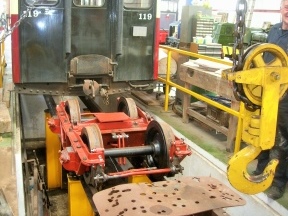
ready for pushing under carriage
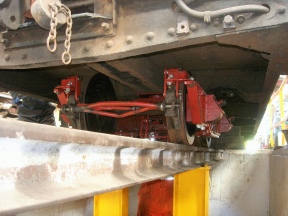
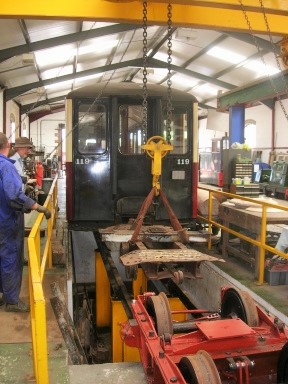
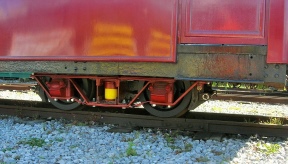
which is outside for testing
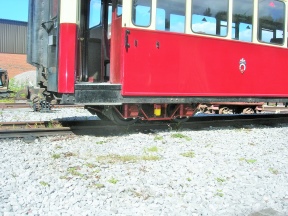
sitting on refurbished bogie
Tuesday 3rd March 2015, will go down as a landmark day in the history of the GVLR. Seven GVLR members were on site, at 8am, to welcome Carriage 119 arrive on a low loader and help unload it.
After 30 minutes of ramp building, the carriage was lowered on to GVLR rails and moved slowly, sandwiched between two locos, down the mainline to the Running Shed. Soon afterwards, a start was made on releasing the bogies, so they can be returned to the Ffestiniog Railway. The carriage will sit on already prepared accommodation bogies, until we are ready to fit its permanent bogies
UPDATE - 12th March 2005 - in the first 5 days after 119's arrival, GVLR engineers have lifted each end of the carriage in turn and released the FR bogies it was sitting on. These were then rolled out and replaced by GVLR accommodation bogies (which were last used during the overhaul of former ALR coach No.4).
A short time before the arrival of 119, two bogies, which had been purchased from Poland over 20 years ago and stored in Brands North Sidings, were both pushed into the Running Shed. One of these has been totally dismantled into its constituent parts. The ensuing task is to clean every item of 100 years worth of dirt and grease, so that they can all be individually assessed for refurbishment or replacement with new parts.
The wheel sets of the first dismantled bogie, which are 60cm in gauge, have been machined on the lathe and a small amount of metal has been removed from the back of each wheel. The GVLR is 24 inch gauge (610mm) and removing the metal allows the wheels to clear the check rails on all our points.
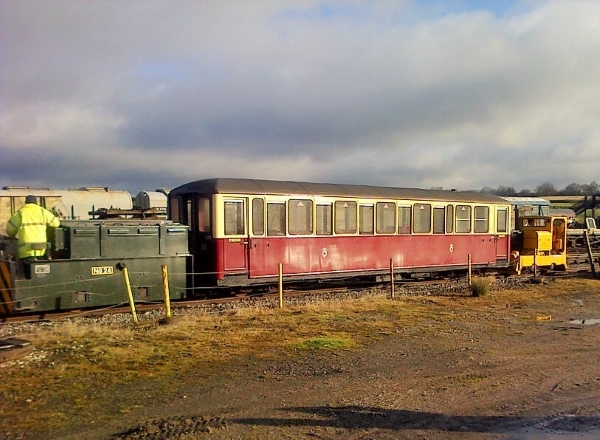

outside GVLR Running Shed
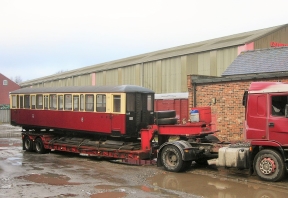
before being unloaded
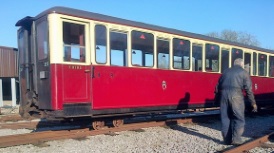
on it's accommodation bogies
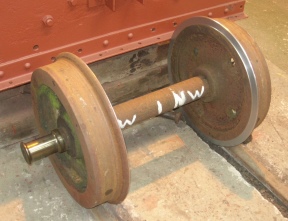
Two steel-bodied bogie carriages which have worked on the Ffestiniog and Welsh Highland Railways since 1980 have been purchased by the Golden Valley Light Railway. Carriage 119 will be delivered to Butterley in the next few weeks and 118 will follow in 2016. They will provide much-improved accommodation for our passengers and give us a substantial increase in passenger capacity.
Carriage 119 was built at Boston Lodge Works in 1980. During the winter of 2006-7 the interior was refurbished, new flooring installed and the seating re-upholstered. In June 2009 the carriage was transferred for use on the Welsh Highland Railway in response to heavy loadings following the launch of services through the Aberglaslyn Pass. 119 continued in service on the WHR during 2010, eventually being transferred back to the FR at the end of the season.
Since then it has remained in regular service and received an interior clean up and exterior repaint just before high summer 2013 and was withdrawn and replaced with a new Super Saloon carrying the same number in late 2014. Carriage 118 is of similar design, having been built in 1977. In 2010, it joined 119 in providing additional passenger accommodation on Welsh Highland services.
Tuesday 3rd March 2015, will go down as a landmark day in the history of the GVLR. Seven GVLR members were on site, at 8am, to welcome Carriage 119 arrive on a low loader and help unload it.
After 30 minutes of ramp building, the carriage was lowered on to GVLR rails and moved slowly, sandwiched between two locos, down the mainline to the Running Shed. Soon afterwards, a start was made on releasing the bogies, so they can be returned to the Ffestiniog Railway. The carriage will sit on already prepared accommodation bogies, until we are ready to fit its permanent bogies


outside GVLR Running Shed

before being unloaded
After negotiations to purchase Carriage 119 body had been concluded, it was stripped of all vacuum equipment by FR staff / volunteers before it left Boston Lodge for Dinas to await transportation to Derbyshire. The Carriage sitting on it's bogies, was picked up by Duncan Milner Haulage on Monday 1st March
The carriage arrived at 8am on Tuesday 2nd March, to be met by a reception party, who helped build a ramp, before 119 was lowered, on to GVLR metals for the first time. Top and Tailed by NG24 and Campbells, the carriage was moved the length of the site to the GVLR Running shed.
The underframe on which carriage 119 sits, was built by the Metropolitan Amalgamated Railway Carriage & Wagon Company (later the Metropolitan Carriage Wagon & Finance Company) in 1923. Between 1909 and 1926, the IOMR mounted two old 4-wheeled carriage bodies, on newly build underframes, to create 26 'new' bogie carriages.
In 1967 the bodies were removed and the bogies and underframes, now called conflats, were used for the short lived container scheme. They then languished at Douglas, loaded with containers, before eventually being sold to Manx Metals in 1974. Nine of the 10 underframes were subsequently purchased by the Ffestiniog Railway.
By now the underframe was known as R10, on which the Ffestiniog Railway in 1980, using components from buses, built Carriage 119, one of the &Tin Carr& family. During the winter 2006-7 the interior was refurbished. including re-upholstered Seating. The exterior was painted in a slight variation of the usual livery and new doors fitted. In June 2009 this carriage along with &sister& 120 was transferred for use on the WHR, in response to heavy loadings after the launch of services through the Aberglaslyn Pass.
119 continued in service on the WHR during 2010, eventually being transferred back to the FR at the end of the 2010 season. Since then it has been in service, and had an interior clean up and exterior repaint into the more usual red and cream livery just before High Summer 2013. 119 was withdrawn and replaced with a Super Barn of the same number in 2014.
